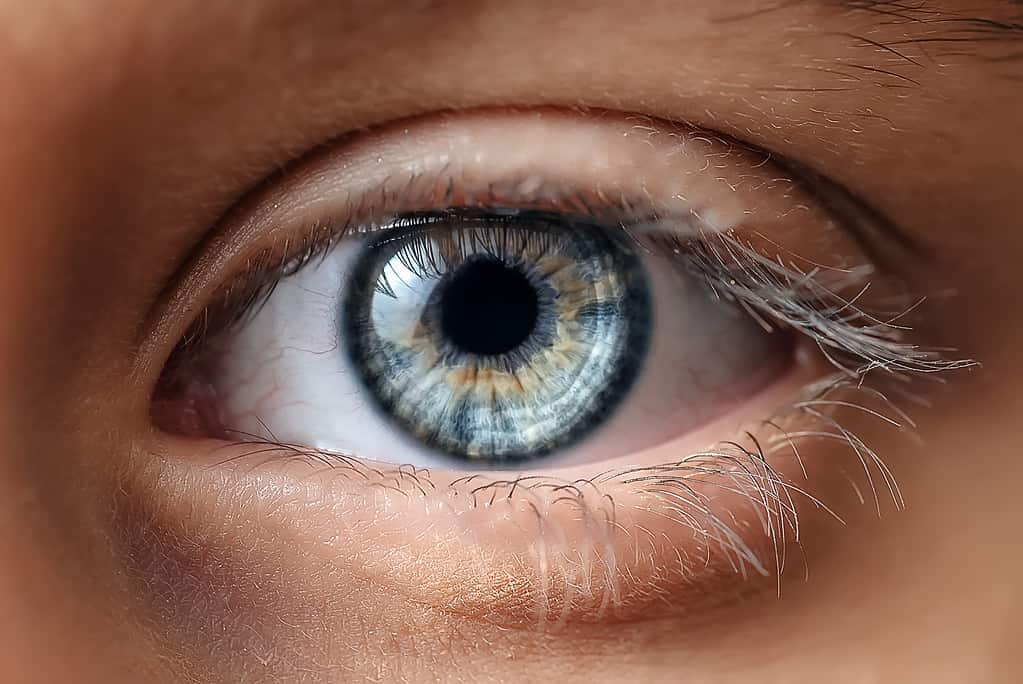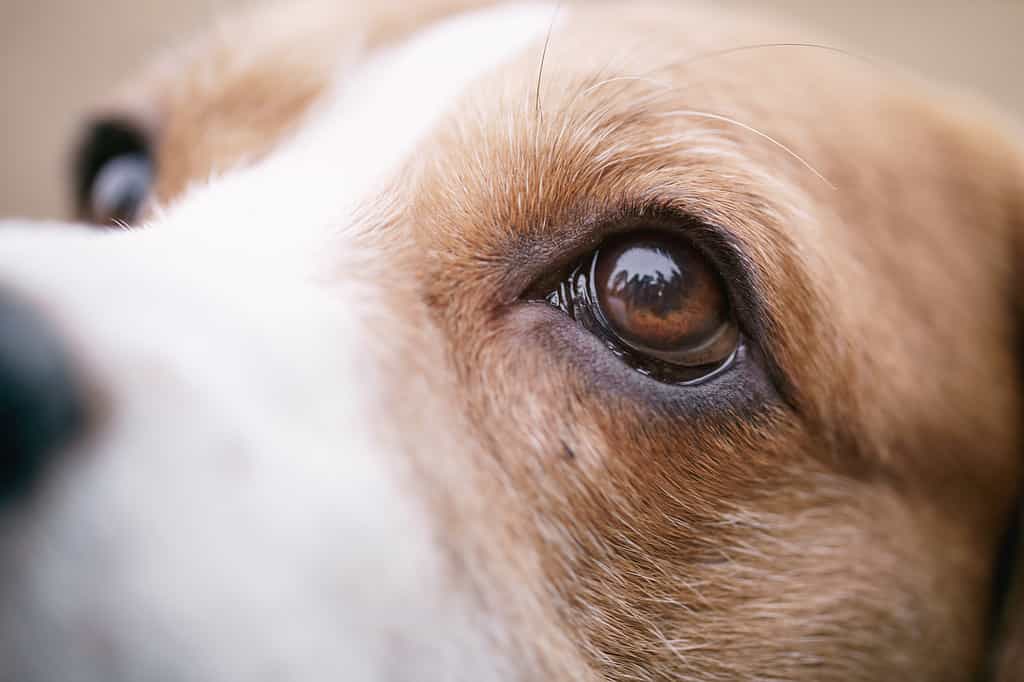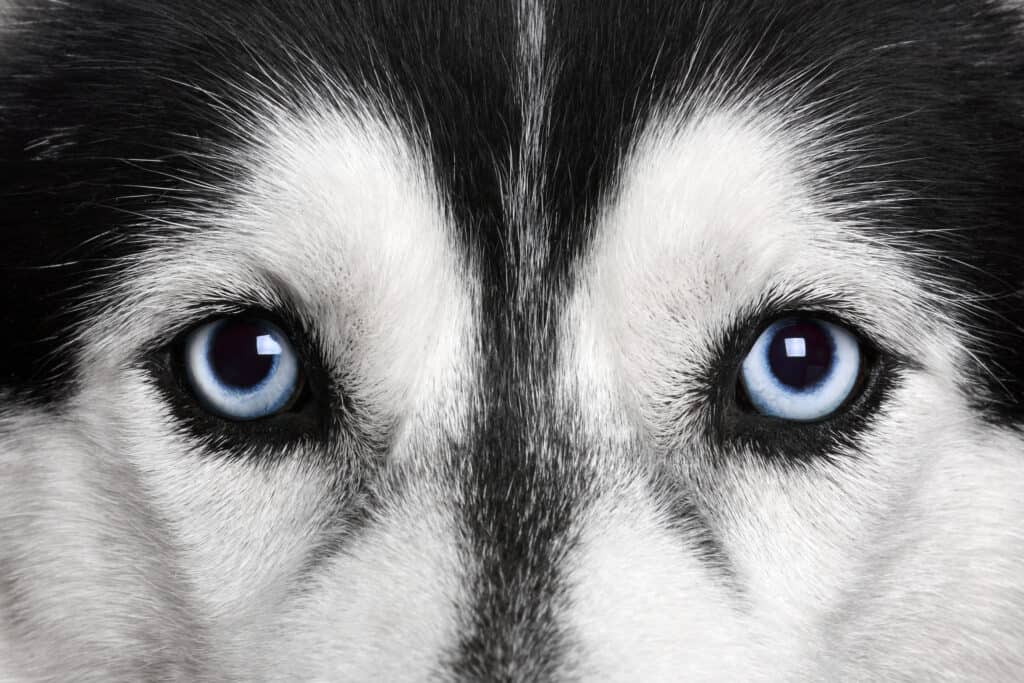Introduction
Have you ever wondered what life looks like through a dog’s eyes? Dogs have a specific eye anatomy that makes their vision unique. While the makeup of a dog’s eye is relatively similar to that of a human’s, certain characteristics cause dog vision to have advantages and disadvantages when compared to human eyes. Discover how dog vision compares to human vision and determine whether humans or dogs see better.
Background on Human Vision

The human eye shares many similarities with dog eyes.
©Edgar Martirosyan/Shutterstock.com
Several parts of the human eye work together to create what we call vision. For instance, when a person looks at an object, light reflects off the object and enters through the cornea. The cornea is the front layer of the eye that bends reflected light. From there, light meets the aqueous humor behind the cornea. The light then passes into the pupil, which describes the black center of the eye’s iris. The iris is the colored part of the eye; when people say they have blue eyes, for example, they describe the iris.
Furthermore, pupils can change size depending on how bright or intense the reflected light appears. The iris of the eye expands or contracts when receiving light, which, in turn, affects the size of the pupil. Following light’s encounter with the pupil, it passes through to the lens. The lens of an eye focuses and bends the light, which clarifies an image. The light that has passed through the lens then is absorbed by the vitreous and transported to the retina.
The retina lies at the back of the eye and includes photoreceptors, which are nerves in the eye. Photoreceptors are comprised of rods and cones. Rods and cones take light and convert it into electrical impulses, which are collected and move through the optic nerve. These electrical impulses eventually reach the optical lobe, which sits within the brain. The brain can then interpret what it sees once electrical impulses meet the optical lobe.
Background on Dog Vision

The abundance of rods in a dog’s eye allows it to see better in the dark than humans.
©GCapture/Shutterstock.com
A dog’s eye interprets light much like the eye of a human. However, the retina of a dog’s eye contains more rods than the human eye and fewer cones. The abundance of rods in a dog’s eye allows it to see better in the dark than humans. On the other hand, the lack of cones in a dog’s eye means that it won’t see color as well as humans see color. In fact, dog eyes have approximately 10% of human eyes’ cones. Thus, many believe that dog vision is similar to the vision of a person that is color blind.
People that are color blind struggle to see the full color spectrum; they often mistake one color for another. There are three primary types of color blindness: deuteranomaly, protanomaly, and tritanomaly. Many believe that dog vision is like the vision of humans with red-green color blindness. Dogs are not technically color blind, though, so the primary types of color blindness do not describe them in completion. However, the term “dichromatic vision” describes the main two types of colors that dogs can discern (blue and yellow).
Similarities and Differences Between Human Vision and Dog Vision
The make-up of the human eye shares many similarities with dog eyes. For one, dogs and humans have eyelids and sclera, the white part of the eye. Both mammals also have corneas, irises, pupils, lenses, and retinas. One last anatomical feature that both humans and dogs have is called the conjunctiva. The conjunctiva is a type of lining on the eyelids that can become inflamed or irritated when it comes into contact with allergens.
On the other hand, some anatomical eye features are unique to dogs rather than to humans. Dogs have a structure called the tapetum lucidum. This feature sits behind the retina and reflects light through the retina. Actions done by the tapetum lucidum increase the amount of light that photoreceptors can convert to electrical impulses. The increase is part of the reason why dogs can see better at night than humans. Furthermore, the tapetum lucidum causes the dog’s eyes to appear as if they “glow” in the dark because of the increased reflected light.
Dogs also have a third eyelid called the nictitating membrane. The eyelid resides in the corner of the dog’s eye near its nose. This feature protects the dog’s eyes from becoming scratched or damaged. It also helps the eye create tears and moisture when the dog blinks. Dog eyes can also vary in coloration. The main kinds of iris pigmentation in dogs include the colors brown, blue, hazel, and gold. Very few dog breeds can have green eyes, but green iris pigmentation is possible.
In addition, dogs’ eyes are set farther apart than the positioning of human eyes, giving them a wider range of peripheral vision. However, their far eye placement decreases their binocular vision. Binocular vision describes the section of vision in which both eyes’ field of view overlap. Humans have greater binocular vision than dogs because their eyes’ field of view overlaps due to their close-eye placement. Binocular vision aids in depth perception. Therefore, humans have a greater depth perception than dogs.
Blindness in Dogs
Like humans, dogs can experience blindness. Some factors that cause dogs to become partially or completely blind include old age and disease. More specific causes of blindness are glaucoma, cataracts, suddenly acquired retinal degeneration, and progressive retinal atrophy. Furthermore, certain dog breeds have a higher risk of experiencing blindness than others. For example, female dogs that are middle-aged are more likely to experience suddenly acquired retinal degeneration than other dogs. Dog breeds that a prone to this disease include mutts, dachshunds, and miniature schnauzers. On the other hand, breeds such as Siberian huskies, poodles, cocker spaniels, and more have a higher risk of experiencing cataracts.
Who Can See Better: Humans or Dogs?

Overall, a dog’s vision is relatively blurry, but this does not mean their vision is necessarily “worse” than human vision.
©244162930/Shutterstock.com
In sum, dogs cannot see as well as humans on the 20/20 scale. A human vision that is considered “normal” or without significant flaws is measured as 20/20. People with 20/20 vision can clearly see an object from 20 feet away. On the other hand, dogs have 20/75 vision. This measurement means that a dog must be 20 feet away from an object to see it as clearly as a human can from 75 feet away. However, some dog breeds have clearer and better eyesight than other breeds. For instance, the Labrador retriever is often used as a seeing-eye dog because it has vision closest to 20/20 vision.
Overall, a dog’s vision is relatively blurry, but this does not mean their vision is necessarily “worse” than human vision. In some cases, dogs have better vision than humans. For example, the rod-dominated retinas of dogs mean that they can see better in the dark than humans. In addition, rod-dominated retinas cause dogs to see moving objects much better than objects that are not moving. In fact, motion sensitivity in dogs is nearly 10 to 20 times greater than motion sensitivity in humans. Finally, dog eyes are spaced farther apart than human eyes, granting them increased peripheral vision.
Regarding dog vision and human vision, neither is particularly “better” than the other. Rather, the two visions are simply different. However, dog vision is, on average, much blurrier than human vision. As a result, one could say that humans see better. On the other hand, dog vision is better than human vision in certain conditions, such as during nighttime or when sensing motion. Therefore, vision for both dogs and humans depends on circumstance. For instance, dogs have greater peripheral vision, while humans see a wider spectrum of color. The anatomy of every species is something that makes their interpretation of the surrounding world unique, especially when it comes to vision.
The photo featured at the top of this post is ©
Ready to discover the top 10 cutest dog breeds in the entire world?
How about the fastest dogs, the largest dogs and those that are -- quite frankly -- just the kindest dogs on the planet? Each day, AZ Animals sends out lists just like this to our thousands of email subscribers. And the best part? It's FREE. Join today by entering your email below.
Thank you for reading! Have some feedback for us? Contact the AZ Animals editorial team.






